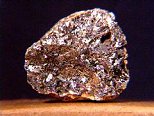 Discovery Information Discovery Information
|
| Who: Known to the ancients. An artefact made of antimony dating to about 3000 BC was found at Tello, Chaldea (part of present day
Iraq), and a copper object plated with antimony dating between 2500 BC and 2200 BC has been found in Egypt.
|
|
 Name Origin Name Origin
|
| Greek: anti (opposed) monos (solitude). Sb comes from the latin, to mark. The exact origin of the name Antimony and the symbol
Sb is a matter of much speculation, with little actual proof.
|
| "Antimony" in different languages. |
|
 Sources Sources
|
| Found in stibnite (Sb2S3) and in valentinite (Sb2O3). Even though this element is not abundant, it is found in over 100 mineral species.
|
| The majority of antimony comes from China, other important reserves are found in Italy, Peru, Mexico, Bolivia and France. Annual production is around 53 thousand tons. |
|
 Abundance Abundance
|
| Universe: 0.0004 ppm (by weight) |
| Sun: 0.001 ppm (by weight) |
| Carbonaceous meteorite: 0.12 ppm |
| Earth's Crust: 0.2 ppm |
| Seawater: 2 x 10-4 ppm
|
|
 Uses Uses
|
| Antimony is increasingly being used in the semiconductor industry in the production of diodes and infrared detectors. |
| Used to the strength and hardness of lead alloys. The most important use of antimony is as a hardener in lead for storage batteries.
|
| It is also used in small arm and tracer bullets, cable sheathing, matches, medicines, and bearings in internal cumbustion
engines.
|
| Antimony compounds in the form of oxides, sulfides, sodium antimonate (NaO3Sb), and antimony trichloride (SbCl3) are used in the making of flame-proofing compounds, ceramic enamels, glass, paints, and pottery. Antimony trioxide (Sb2O3) is the most important of the antimony compounds and is primarily used in flame-retardant formulations. These flame-retardant applications include such markets as children's
clothing, toys, aircraft and automobile seat covers.
|
|
 History History
|
| Antimony's sulfide compound, antimony (III) trisulfide, Sb2S3 was recognized in antiquity, at least as early as 3000 BC. Pastes of Sb2S3 powder in fat or in other materials have been used since that date as eye cosmetics in the Middle East and farther afield;
in this use, Sb2S3 is called "kohl". It was used to darken the brows and lashes, or to draw a line around the perimeter of the eye.
|
| An artefact made of antimony dating to about 3000 BC was found at Tello, Chaldea (part of present day Iraq), and a copper object plated with antimony dating between 2500 BC and 2200 BC has been found in Egypt.
|
|
 Notes Notes
|
| Antimony in its elemental form is a silvery white, brittle, fusible, crystalline solid that exhibits poor electrical and heat
conductivity properties and vapourizes at low temperatures. A metalloid, antimony resembles a metal in its appearance and
physical properties, but does not chemically react as a metal. It is also attacked by oxidizing acids and halogens. Antimony and some of its alloys are unusual in that they expand on cooling.
|
|
 Hazards Hazards
|
| Antimony and many of its compounds are toxic. Clinically, antimony poisoning is very similar to arsenic poisoning. In small doses, antimony causes headache, dizziness, and depression. Larger doses cause violent and frequent vomiting,
and will lead to death in few days. It is a skin, eye and respiratory irritant.
|





 Discovery Information
Discovery Information
 Name Origin
Name Origin
 Sources
Sources
 Abundance
Abundance
 Uses
Uses
 History
History
 Notes
Notes
 Hazards
Hazards
 Images
Images

